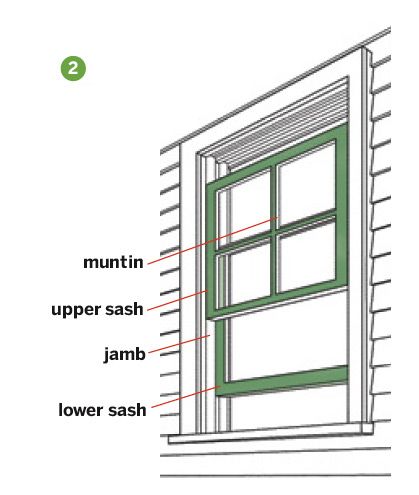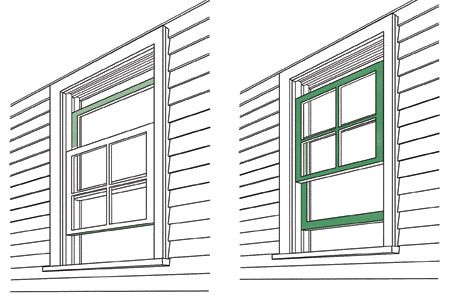Painting double-hung windows from the outside is a great way to freshen up your home’s look. It takes a bit of planning, but with some simple steps, you can get a smooth, long-lasting finish that protects your windows and makes them look new again.
What Are Double-Hung Windows?
Double-hung windows have two sections, or sashes, that slide up and down within the window frame. Both the top and bottom sashes can be opened, which helps with airflow and makes cleaning easier.
Before you start painting, it helps to know the main parts of the window:

- Jambs: The sides of the window frame.
- Muntins: Strips of wood or metal that divide the glass panes.
- Rails: Horizontal parts of the sash.
- Sashes: The movable panels that hold the glass.
- Stiles: Vertical parts of the sash.
- Stops: Trim pieces that hold the sash in place.
Tools and Materials for Painting Double-Hung Windows
Before you begin, make sure you have the following items on hand:
- Cleaning supplies (soap, water, sponge)
- Drop cloths
- Exterior paint suitable for windows
- Paint stirrer
- Paintbrushes (angled and flat)
- Painter’s tape
- Primer (if needed)
- Safety gear (gloves, eye protection)
- Sandpaper (fine grit)
- Scraper or putty knife
How To Paint Your Double-Hungs From the Outside
Once you have your tools and materials ready, follow these steps to get the job done right.
1. Clean and Prime the Window
Start by getting the window surface ready with these steps:
- Remove any dirt, dust, or peeling paint with a scraper or putty knife.
- Wash the windows with soap and water, then allow them to dry completely.
- Sand any rough areas lightly with fine-grained sandpaper.
- If the window has bare wood or the old paint is in rough shape, put on a coat of exterior primer. This will help the new paint stick better and protect the wood.
- Allow the primer to dry according to the manufacturer’s instructions.
You can use painter’s tape to keep paint off of the areas you aren’t painting.
2. Position the Sashes
Unlock the window and raise the lower sash about two-thirds of the way up. Then, lower the upper sash about two-thirds of the way down. This setup lets you reach most of the window without having to move the sashes too much as you work.
3. Paint the Lower Sash
Painting pro and This Old House contributor John Dee of Concord, Massachusetts, recommends starting with the lower sash. As you paint, use steady, even strokes along the edge of the glass. Avoid getting paint on the sash, stops, or glass.
- Paint the muntins (if there are any), and then move on to the rails and stiles. Leave a thin line of paint—about 1/16 of an inch—on the glass. This helps seal the edges and keeps moisture from getting under the paint.
- If paint accidentally gets on the sash or stops, wipe it up immediately. If paint gets on the glass, use a razor blade to remove it while it’s still wet.
- Paint the remaining portion of the lower sash, being careful to wipe up any excess paint.
4. Paint the Upper Sash
Paint the muntins of the upper sash first, then move on to the rails and stiles. Keep that 1/16-inch bead of paint on the glass edges for a proper seal. Be careful not to paint the jambs or stops, as this can interfere with the window’s operation and make it stick.
5. Allow the Paint To Dry
Once you’ve finished the first coat, give the paint time to dry:
- If needed, apply additional coats, but always let the paint dry completely between layers.
- To avoid sticking, move the sashes up and down every so often as the paint dries.
- Keep the windows open for about 24 hours to fully dry and avoid sticking. A fan can help speed up the drying process.
6. Make Any Final Adjustments
Once the paint is fully dry, it’s time for some final touches:
- Carefully remove any painter’s tape.
- Touch up any areas that may need it.
- Clean the glass thoroughly to remove any paint specks or residue.
- Test the windows to make sure they’re operating properly.
We recommend storing the leftover paint for any future touch-ups.
Double-Hung Window Painting Tips
Here are a few more pro tips to make the job easier:
- Don’t over-apply paint, especially on areas that touch when the window is closed.
- Use an angled brush for corners and tight spots.
- Apply thin, even coats rather than one thick coat.
- Make sure you’re working in good lighting so you don’t miss any spots.
- Check your work from different angles to make sure everything’s covered.
- Use a small brush or cotton swab for precise application in difficult-to-reach spots.
Maintaining Your Newly Painted Windows
After all your hard work, you’ll want to keep your windows looking fresh. Here’s how to maintain them:
- Dust the window frames and sills regularly.
- Wash the windows with mild soap and water at least twice a year.
- Avoid harsh cleaners that could damage the paint.
- Clear out any debris that might get stuck in the window tracks.
- Fix any chips or scratches quickly to prevent further damage—just clean the area, sand it lightly, and touch it up with your leftover paint.

